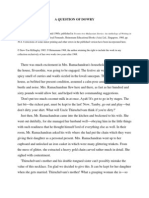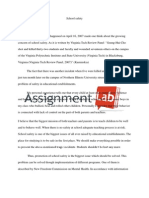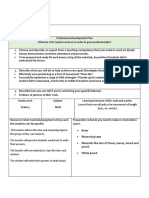Professional Documents
Culture Documents
Bullies
Bullies
Uploaded by
Aillen Laureint AbulanOriginal Description:
Copyright
Available Formats
Share this document
Did you find this document useful?
Is this content inappropriate?
Report this DocumentCopyright:
Available Formats
Bullies
Bullies
Uploaded by
Aillen Laureint AbulanCopyright:
Available Formats
FS-570
Bullies
When I was a young boy, What bullying is What bullying
the bully called me names,
stole my bicycle, forced With all the focus that has surrounded can look like in
me off the playground.
teenage gangs and gun violence, it may
be easy to forget that the teenage years
elementary school
He made fun of me in
are not the only times that children face Being a victim is the most common
front of other children,
violent behavior. In fact, aggressive in second grade, and the likelihood of
forced me to turn over
behavior and bullying are even more being bullied decreases each year after
my lunch money each day, that (see Figure 1). Bullies in elementary
common in elementary school than in
threatened to give me junior and senior high! Some studies school are more likely to pick on children
a black eye if I told suggest that around 20 percent of all younger than themselves. Bullying is
adult authority figures. American children have been the victim often very physical in nature, with open
At different times I was of bullying at some point in elementary attacks of aggression being the most
subject to a wide range of school, and about the same number common. Boys are more likely to be
degradation and abuse – have described themselves as engaging doing the bullying, but girls and boys
de-pantsing, spit in my face, in some form of bullying behavior. are equally likely to be victims.
forced to eat the playground Bullying can range from teasing, to
dirt....To this day, their stealing lunch money, to a group of
handprints, like a slap students physically abusing a classmate. What bullying
on the face, remain stark
Even though bullying is very similar to can look like in
and defined on my soul.
other forms of aggression, there can be junior high school
Eric E. Rofes – some distinctive features:
Making our Schools Safe for Sissies Bullies in junior high school are more
• The intention of bullying behavior likely to pick on people their same age,
is purposeful, rather than accidental with boys more likely to be both bullies
• The goal is to actually gain control and victims. Girls, when they do bully,
over another child through physical are more likely to verbally harass
or verbal aggression. someone than be physical. Boys
• Usually bullies make their attack sometimes use physical attacks, but
without any real reason, other than they are also more likely to threaten and
they see their victim as an easy target. harass one of their peers in a verbal way.
• Bullies are usually more popular
with their peers than children who
North Dakota State University are simply aggressive.
Fargo, North Dakota 58105
Reviewed and reprinted March 2009
20 –
–
– 17.5
–
BOYS 1234567890123
1234
16
1234 1234567890123
–
1234 14.5 GIRLS 1234567890123
1234567890123
15 – 1234
1234
– 1234 13
Percent Victims
– 1234
1234 12345
12.2
12345 12345
11.5
– 1234 12345 12345
– 1234
1234 12345
12345
12345
12345
10.6
10 – 1234
1234 12345
12345
12345
12345 12345
8.9
– 1234 12345 12345 12345 8.4 8
– 1234
1234 12345
12345 12345
12345 12345
12345
7.7
– 1234
1234 12345
12345
12345
12345 12345
12345
6.4
– 1234 12345 12345 12345 12345
5.5
5– 1234
1234 12345
12345
12345
12345 12345
12345 12345
12345
– 1234
1234 12345
12345 12345
12345 12345
12345 12345
12345 1234
3.3
1234 12345
3.5
12345 12345
3
– 1234
1234 12345
12345
12345
12345 12345
12345 12345
12345 1234
1234 12345
12345 12345
12345
– 1234
1234 12345
12345
12345
12345 12345
12345 12345
12345 1234
1234 12345
12345 12345
12345
– 1234 12345 12345 12345 12345 1234 12345 12345
0–
Grade 2 Grade 3 Grade 4 Grade 5 Grade 6 Grade 7 Grade 8 Grade 9
Figure 1. Percentage of student in different grades who reported being bullied (being exposed to direct bullying).
(total number of boys = 42,390; total number of girls = 40,940.)
What it means to be a bully Peer rejection
Researchers who are interested in how children form
Living in a society where wealth and power are admired, relationships with their peers have identified four
film heroes regularly beat up and kill others, and the weak categories that describe how children relate to peers,
and sick are often despised, it is no surprise that some based on having children name children that they like
children have learned to imitate these values. Research has as well as children that they don t like:
shown that although bullies tend to have difficulty making
friends, they do gain a certain level of popularity and peer • Popular children are those that many children
status for their actions. It is possible that bullies may be say they like, and few children say that they dislike.
enjoying more respect and admiration from their peers, These children have developed positive social and
and bullying behavior, especially among boys, can often communication skills.
be considered normal behavior. • Controversial children are both actively liked and
disliked by many of their peers. They tend to have
good social skills, but also exhibit aggressive behavior.
Causes of bullying Class clowns often fit into this category.
• Rejected children are actively disliked by many of their
Parental relationship
peers and well liked by few of their peers. They show
Bullies tend to come from families that are characterized as
high rates of conflict, aggression, and immature play,
having little warmth or affection. These families also report and they have trouble taking the perspective of another
trouble sharing their feelings and usually rate themselves person. They also have a hard time solving problems
as feeling less close to each other. Parent of bullies also tend without resorting to violence. Rejected children are often
to use inconsistent discipline and little monitoring of where prone to delinquency and dropping out of school later.
their children are throughout the day. Sometimes parents
• Neglected children are seldom neither liked or disliked
of bullies have very punitive and rigid discipline styles, by their peers. Although they are very shy, and may
with physical punishment being very common. Bullies have low self-esteem, many neglected children do very
also report less feelings of closeness to their siblings. well in school and are able to develop friends as they
approach adolescence.
School failure
Bullies are usually not model students. Very often they are Bullies come most often from the rejected category,
not doing well in school and do not have good connections but they sometimes are popular children as well.
with their teachers. Victims can be selected from any category, although
neglected children often are more likely to be victims.
What it means to be a victim Long term effects of being a victim
The long term consequences of being a victim vary a good
Unfortunately in recent years, our attitudes have changed deal. Most victims of bullying do well in school and are
about what it means to be a victim. Many parents and able to make friends are they grow older. Most victims,
school officials are likely to blame victims of bullying for especially if they receive support from adults important in
being weak and not being able to stand up for themselves. their lives, survive the experience of being bullied without
This, coupled with the fact that victims are usually warned long term effects.
by bullies not to tell anyone, makes it difficult for them to
talk with parents and teachers. Short term effects of being a bully
Ten percent of children could be considered extreme Even though bullies are sometimes viewed positively by
victims who have been the victim of bullies at least their peers, they rarely are capable of maintaining close
once a week for a long period of time. These children friendships. They are usually not doing well in school
are often considered younger, weaker, or sicker by and not well liked by their teachers.
their peers. Victims are just as likely to be boys as girls.
They often report strong fears or dislike of going to school. Long term effects of being a bully
These children often report closer feelings to parents and Bullying is a behavior that is very often one of the first
siblings, but whether this causes them to be victims or steps to more serious problems. Unless some kind of
is simply how they cope with being bullied is unclear. intervention takes place, the aggression of bullying often
Being labeled a victim is likely to follow children around leads to more serious acts of delinquency and criminal
from year to year. Most extreme victims report having activity. Bullies are also more likely to use drugs and
few or no friends and being alone at recess and lunch. alcohol as adolescents.
Symptoms that a child might be a victim of bullying: Suggestions for working with bullies:
• acts moody, sullen, or withdraws from family interaction • Work in small groups. It is often helpful to place bullies
in groups with older children and have them engage in
• becomes depressed
cooperative tasks. It will be necessary to provide a great
• loses interest in school work, or grades drop deal of supervision.
• loses appetite or has difficulty getting to sleep • Reinforce children each time they engage in some
• waits to use the bathroom at home degree of caring or pro-social behavior. It will be easier
to establish more appropriate rules for interaction after
• arrives home with torn clothes, unexplained bruises
they learn that there are more positive ways to gain
• asks for extra money for school lunch or supplies, attention and affection.
extra allowance
• Often children who are having a hard time relating to
• refuses to go to school (15 percent of all school other children can learn some social skills with pets.
absenteeism is directly related to fears of being Under close supervision, bullies may learn to care for
bullied at school) and show affection to a dog or cat.
• wants to carry a protection item, such as a knife • Work with families to determine ways they can show
warmth and affection to their children, and seek to
Consequences of bullying develop a more consistent set of discipline. Sometimes
it is helpful for families to become more involved in
Short term effects of being a victim community activities and become friends with other
Being a victim is very stressful for children. Many children parents.
develop a strong dislike of going to school, especially times
like recess or gym class. Many victims begin to distrust all Suggestions for working with victims:
their peers at school and have problems making friends. • Often victims, particularly those who have been
Extreme victims can develop depression or physical illness. victimized many times, are withdrawn and are afraid
of social interaction. These children often profit from
social interactions with younger children, where they
may be less afraid to open up or show some leadership.
• Practice with kids some strategies of ways they can
respond when being bullied. Help them identify times
when they are likely to be harassed, and see if there are
ways to avoid those situations. Determine the exact What parents can do:
nature of the bullying behavior, and help them • Create a safe environment for your children to tell you
practice some things to say or do. Here are some about being bullied. Many times kids are embarrassed
specific strategies: to tell their parents what happened, thinking that their
– Laugh or ignore comments or teasing. Bullies delight in parents will blame them. Sometimes kids at school pick on
you being scared and getting a big reaction. Eventually other kids or say mean things to them. Does this ever happen
they will leave you alone. to you at school?
– Tell them to buzz off or shout GO AWAY!! Say it as • Reinforce the idea that if they are being bullied, it is
angrily as you can and walk away immediately. not their fault. Don’t make your child feel like a wimp.
Practice in the mirror. The person that is picking on you is the one with a problem,
– Stay with a crowd – bullies usually pick on kids who are not you. Bullies pick on people for no real reason, but it is
alone. Suggest that children walk to school or sit on the just because they have problems of their own, not because
bus with someone who can protect them. of anything you have done.
– If you are alone with a crowd that picks on you, ask him • Don t teach your kids to hit or fight back; it will only
or her why she is mean to you. make things worse. Here are five steps that are be good
to suggest:
• For both groups, it is helpful to pair them up with
– Ignore
children who are neither bullies nor victims, as they
– Move away
can be great teachers of appropriate behavior.
– Ask to stop
– Tell firmly to stop
What schools can do:
– Tell an adult.
• Get an accurate assessment of the problem. An
anonymous survey is a very effective way to learn
• Notify teachers whenever an incident happens, be
about the true nature of a problem at a particular school.
prepared to be persistent until some action is taken!
• Maintain higher visibility. Most schools report that most Ask the teacher: Would it be possible to have the class
of their bullying problems disappear when playgrounds, get involved in a discussion about bullies, or to separate
bathrooms, etc., are properly monitored. Supervising my child from those who are bothering them?
recess is especially important.
• If your child is unwilling to report another child’s behav-
• Have students develop class rules about bullying that ior to a teacher, offer to make the complaint yourself.
are then consistently reinforced. It is important to start Stress that it can be done in a way that is confidential.
this in very early grades to gain a handle on this problem
before it gets out of control.
Resources
• Conduct in-service training for both teachers and Verdine Ryder (Family Life Educator). Beat the bully problem.
parents. Stress that bullying is not just boys being boys This book provides self-help skill and pro-active solutions
or high spirited behavior but potentially damaging for of bullying behavior. Cost $5.95, call 713-871-3172 to order.
both victims and bullies. Bullying is not something that G.M. Batsche and H.M. Knoff. Bullies and their victims:
people grow out of, but one of the first signs of more Understanding a pervasive problem in the schools.
serious problems. It is also important to remember that School Psychology Review, 23, 2, 165-174.
verbal harassment can be just as scary and intimidating
as physical attacks.
• Have serious talks with bullies, and make them realize Laura DeHaan, Ph.D.
that you are aware of their behavior and are not going Assistant Professor of Child Development, NDSU
to tolerate it. It is also important to develop ways to Reviewed and revised by
help them learn more positive social skills. Sean Brotherson, Ph.D.
Family Science Specialist, NDSU Extension Service
For more information on this and other topics, see: www.ag.ndsu.edu
This publication may be copied for noncommercial, educational purposes in its entirety with no changes.
Requests to use any portion of the document (including text, graphics or photos) should be sent to NDSU.permission@ndsu.edu.
Include exactly what is requested for use and how it will be used.
North Dakota State University does not discriminate on the basis of race, color, national origin, religion, sex, disability, age, Vietnam Era Veterans status,
sexual orientation, marital status, or public assistance status. Direct inquiries to the Chief Diversity Officer, 205 Old Main, (701) 231-7708.
County Commissions, NDSU and U.S. Department of Agriculture Cooperating.
This publication will be made available in alternative formats for people with disabilities upon request, (701) 231-7881. 250-6-06; 2M-3-09
You might also like
- D S HandbookDocument113 pagesD S HandbookJunio Ares88% (16)
- A Dominants Handbook With Exam 26-11Document113 pagesA Dominants Handbook With Exam 26-11Steve Muskles70% (10)
- Ever After High General VillainyDocument168 pagesEver After High General VillainyPorco VoadorNo ratings yet
- Bible Charades CardsDocument2 pagesBible Charades CardsAillen Laureint AbulanNo ratings yet
- 12 Rules For Life: Book SummaryDocument8 pages12 Rules For Life: Book SummaryGaurav Chauhan75% (4)
- Mindful Conflict HandoutsDocument11 pagesMindful Conflict HandoutsDana Michele Rivera CastroNo ratings yet
- Anti BullyingDocument2 pagesAnti BullyingUr CrushNo ratings yet
- How To Report Bullying EnglishDocument1 pageHow To Report Bullying EnglishWHSNo ratings yet
- What If I'm Being BulliedDocument5 pagesWhat If I'm Being BulliedAlexPemaNo ratings yet
- Bullying 2014Document23 pagesBullying 2014api-235469121No ratings yet
- Howtobean Advocate For Bullied StudentsDocument2 pagesHowtobean Advocate For Bullied StudentsAC ConNo ratings yet
- Compliance: With IEC EN 61508:2010Document7 pagesCompliance: With IEC EN 61508:2010Mohamed OmarNo ratings yet
- Writeshop Parent's ConsentDocument2 pagesWriteshop Parent's ConsentDivina Gracia Barrion CuyaNo ratings yet
- BulliedDocument7 pagesBulliedgeorgereyes3No ratings yet
- BullyDocument9 pagesBullyJoelebieNo ratings yet
- Certificate of Recognition Resource SpeakerDocument4 pagesCertificate of Recognition Resource SpeakerMary Cris OrellanaNo ratings yet
- TLOCDocument3 pagesTLOCRJ GabuyaNo ratings yet
- Intervention Logic Indicators Baseline Target Means of Verification Assumption S Inputs Objective 1: Outcome 1.1Document4 pagesIntervention Logic Indicators Baseline Target Means of Verification Assumption S Inputs Objective 1: Outcome 1.1Muhammad MudassirNo ratings yet
- Republic of The Philippines Matalino St. D.M. Government Center, Maimpis, City of San Fernando (P)Document45 pagesRepublic of The Philippines Matalino St. D.M. Government Center, Maimpis, City of San Fernando (P)ShoeviceNo ratings yet
- 5th Grade March NewsletterDocument1 page5th Grade March NewslettersstoubeNo ratings yet
- Assessing Contribution of Research in Business To PracticeDocument5 pagesAssessing Contribution of Research in Business To PracticeAga ChindanaNo ratings yet
- LDM Practicum Portfolio LedyDocument20 pagesLDM Practicum Portfolio LedyJennifer Balanga MunarNo ratings yet
- Literacy Block Lesson PlanDocument2 pagesLiteracy Block Lesson Planapi-500183943No ratings yet
- STRATEGIC Intervention Materials: MatterDocument12 pagesSTRATEGIC Intervention Materials: MatterKen Charles GomezNo ratings yet
- Risk Management GuidanceDocument9 pagesRisk Management GuidanceHelen GouseNo ratings yet
- Campusjournalism NewswritingDocument34 pagesCampusjournalism Newswritingלארה מאיNo ratings yet
- Science and Technology WritingDocument14 pagesScience and Technology WritingMary Ann AysonNo ratings yet
- Bullying at School - The No-Blame ApproachDocument5 pagesBullying at School - The No-Blame ApproachDespina KalaitzidouNo ratings yet
- Minutes SBMDocument4 pagesMinutes SBMLorna NavarroNo ratings yet
- Parental Involvement and The Impact On Students Literacy DevelopDocument62 pagesParental Involvement and The Impact On Students Literacy DevelopPatrizzia Ann Rose OcbinaNo ratings yet
- SBM Movs ValidationDocument14 pagesSBM Movs Validationronald malabayNo ratings yet
- A Question of DowryDocument5 pagesA Question of DowryMellsielle Edoralina Louna100% (1)
- Code of Ethics PowerDocument36 pagesCode of Ethics PowerIan Baitan PabionaNo ratings yet
- School Safety/ Essay / PaperDocument5 pagesSchool Safety/ Essay / PaperAssignmentLab.comNo ratings yet
- Easy and Fun Ideas To Improve Writing Skills For ChildrenDocument5 pagesEasy and Fun Ideas To Improve Writing Skills For ChildrenNeuf ChevaliersNo ratings yet
- Difference Between GDP and GNP PDFDocument2 pagesDifference Between GDP and GNP PDFAarushi LuniaNo ratings yet
- 6 Kafeel Ahmed Choudhury PDFDocument7 pages6 Kafeel Ahmed Choudhury PDFSuperconsistantNo ratings yet
- Frayer Model StrategyDocument3 pagesFrayer Model Strategyeva.bensonNo ratings yet
- Rm-No.-184-S.2017 Regional Training in Campus Journalism CaravanDocument6 pagesRm-No.-184-S.2017 Regional Training in Campus Journalism CaravanCarmela Isabelle DisilioNo ratings yet
- Close Reading PDFDocument32 pagesClose Reading PDFSamKris Guerrero MalasagaNo ratings yet
- Child AbuseDocument2 pagesChild AbuseseserNo ratings yet
- Baffle InstallationDocument1 pageBaffle Installationلملي عبداللهNo ratings yet
- Poster Tama - o A4Document8 pagesPoster Tama - o A4Xamira CariNo ratings yet
- Escala Messy para El AlumnoDocument4 pagesEscala Messy para El AlumnoVictorlbdr 18No ratings yet
- Jay McGraw's Life Strategies for Dealing with BulliesFrom EverandJay McGraw's Life Strategies for Dealing with BulliesRating: 2.5 out of 5 stars2.5/5 (7)
- Olivia Rodrigo - Pretty Isn't Pretty Lyrics Genius LyricsDocument1 pageOlivia Rodrigo - Pretty Isn't Pretty Lyrics Genius LyricsMarina Marquez0% (1)
- Tukushka Minga VirtualDocument20 pagesTukushka Minga Virtualalison_hicksNo ratings yet
- Chinese Pinyin ChartDocument1 pageChinese Pinyin ChartSyed Uzair AliNo ratings yet
- Hypertherm ANTORCHAS PTE-PTS EasyFit PlasmaCutDocument16 pagesHypertherm ANTORCHAS PTE-PTS EasyFit PlasmaCutsw8n5mmcknNo ratings yet
- c090 Assigned UsersDocument4 pagesc090 Assigned UsersMichael ArevaloNo ratings yet
- Magical Fury Companion: by Ewen CluneyDocument15 pagesMagical Fury Companion: by Ewen CluneyChristina MacDonald100% (2)
- Eve TeasingDocument13 pagesEve TeasingIrma Meow ChowdhuryNo ratings yet
- My Second Latino Scene Book: 50 Two-Minute Scenes for Young ChildrenFrom EverandMy Second Latino Scene Book: 50 Two-Minute Scenes for Young ChildrenRating: 5 out of 5 stars5/5 (1)
- KS3-4 ABW PowerpointDocument36 pagesKS3-4 ABW PowerpointFlordeliza Manaois RamosNo ratings yet
- Speaking Comprehension Questions For SCOALA GIMNAZIALA NR 1 ALBESTI-1Document2 pagesSpeaking Comprehension Questions For SCOALA GIMNAZIALA NR 1 ALBESTI-1MihaelaMirzaNo ratings yet
- Sheffield Materials FinalDocument17 pagesSheffield Materials Finalapi-357529176No ratings yet
- The Girl Who Knows Too MuchDocument3 pagesThe Girl Who Knows Too MuchsalonyNo ratings yet
- Respect or Bullying FlashcardsDocument15 pagesRespect or Bullying Flashcardssiti hajarNo ratings yet
- Olivia Rodrigo - Logical Lyrics Genius LyricsDocument1 pageOlivia Rodrigo - Logical Lyrics Genius LyricsnataliestefanovaNo ratings yet
- 1layout and Page Design TalkDocument23 pages1layout and Page Design TalkAillen Laureint AbulanNo ratings yet
- 4th QuarterDocument15 pages4th QuarterAillen Laureint AbulanNo ratings yet
- Assessment in English 8 LeviticusDocument1 pageAssessment in English 8 LeviticusAillen Laureint AbulanNo ratings yet
- He Endured The CrossDocument3 pagesHe Endured The CrossAillen Laureint AbulanNo ratings yet
- RM 201 Exercise No. 1Document3 pagesRM 201 Exercise No. 1Audrey Kristina MaypaNo ratings yet
- Lesson Plan CM MM MDocument6 pagesLesson Plan CM MM Mapi-356065858No ratings yet
- Alzheimer's - Brain WorksheetDocument1 pageAlzheimer's - Brain WorksheetCamilo SepulvedaNo ratings yet
- Change 2Document52 pagesChange 2Alwyn PintoNo ratings yet
- Gratitude PDFDocument7 pagesGratitude PDFAdhdNo ratings yet
- Mental Help Seeking Attitudes Scale MHSASDocument1 pageMental Help Seeking Attitudes Scale MHSASezazpsychologistNo ratings yet
- 43 Self-Assessment in The Classroom: Mats OscarsonDocument18 pages43 Self-Assessment in The Classroom: Mats OscarsonYerson Enrique Gomez ArboledaNo ratings yet
- Negotiation According To TrompenaarDocument15 pagesNegotiation According To TrompenaarChouaib NejmaouiNo ratings yet
- Strain Theory ReconsideredDocument17 pagesStrain Theory ReconsideredUtorkovo NasiljeNo ratings yet
- 6 M's To Keep in Mind When You Next See A Patient With Anorexia NervosaDocument2 pages6 M's To Keep in Mind When You Next See A Patient With Anorexia Nervosaaaycee100% (1)
- Touchstone 2 Ideas For Handling Pair Work and Group WorkDocument1 pageTouchstone 2 Ideas For Handling Pair Work and Group WorkDreamJustADream INo ratings yet
- Transgenderism, Based On WhatDocument3 pagesTransgenderism, Based On WhatChris Oliver C. Dela CruzNo ratings yet
- Stressor SDocument4 pagesStressor SEd PinedaNo ratings yet
- Chapter 4 Components of Special and Inclusive EducationDocument23 pagesChapter 4 Components of Special and Inclusive EducationDe Vera Thristan Blue100% (1)
- Cot Lesson 2 Per Dev q1 2023-24Document32 pagesCot Lesson 2 Per Dev q1 2023-24Charlene Binasahan100% (1)
- Module 10: Challenging Maladaptive Thoughts and Beliefs: ObjectivesDocument7 pagesModule 10: Challenging Maladaptive Thoughts and Beliefs: ObjectivesMaria BagourdiNo ratings yet
- Nursing Clinical JudgementDocument5 pagesNursing Clinical Judgementapi-352157080No ratings yet
- A Correlational Study On The Relationship Between Research Anxiety and Self-Efficacy For Ethics Review Committee - FinalDocument42 pagesA Correlational Study On The Relationship Between Research Anxiety and Self-Efficacy For Ethics Review Committee - FinalClarissa Victoria Lumain100% (1)
- Iser, W. 1972. The Reading Process. A Phenomenological ApproachDocument22 pagesIser, W. 1972. The Reading Process. A Phenomenological ApproachJuan Camilo Soto100% (1)
- VAVampire - New (5th Gen)Document2 pagesVAVampire - New (5th Gen)Adriano YonezawaNo ratings yet
- Freud Beyond The Pleasure PrincipleDocument8 pagesFreud Beyond The Pleasure PrincipleKhushboo SharmaNo ratings yet
- Book 4 The Object RelationsDocument471 pagesBook 4 The Object Relations田惠宁No ratings yet
- Let RevDocument22 pagesLet RevJay-ar TubogNo ratings yet
- Sifter PDFDocument2 pagesSifter PDFAnn VillablancaNo ratings yet
- Abstract - Using The Balanced Activity ApproachDocument2 pagesAbstract - Using The Balanced Activity ApproachkadiruNo ratings yet
- Garbage Can ModelDocument3 pagesGarbage Can ModelHozefadahodNo ratings yet
- NPTEL Leadership 51Document33 pagesNPTEL Leadership 51haardik.mishra020No ratings yet
- Quality of Work-Life Model For Teachers of Private Universities in PakistanDocument23 pagesQuality of Work-Life Model For Teachers of Private Universities in PakistanNisreen Al-shareNo ratings yet






























































































